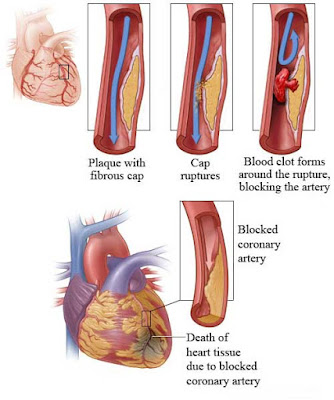Atherosclerosis:
Atherosclerosis is a disease of large and medium-sized muscular and elastic arteries. It is a slowly progressive disease that begins in childhood and becomes manifested late in life. The basic lesions in atherosclerosis are atheromas that weaken the media and predispose the area to thrombus formation.
Atheromas:
These are raised focal plaques within the intima (the innermost layer of blood vessels) having a core of lipids which is covered by a fibrous cap
The plaques increase in size and may block the arteries and compromise the blood supply of the area supplied by that artery. (for example, it may cause a Heart attack if a coronary artery is blocked by plaques)
Risk Factors and Cause:
1. Age:
Though early lesions of atherosclerosis appear in childhood, the disease is rare before 30 years of age and usually affects older people.
2. Sex.
- Males are affected more than females
- Estrogens have some protective effect therefore, women are less commonly affected by disease before menopause, the incidence in females increases after menopause and become equal to males after the age of 75.
3. Inheritance.
A genetic predisposition for other risk factors, for example, hypertension, diabetes can induce an increased prevalence for atherosclerosis. Inherited disorders of lipoprotein metabolism also increase the risk of atherosclerosis.
4. Acquired hyperlipidemia
Fatty diet and reduce exercise may increase the bad cholesterol levels in the blood which predispose to the development of atherosclerosis.
Bad cholesterol circulates in the form of LDL (low-density lipoproteins). Higher the level of LDL in blood greater are the chances of getting atherosclerosis.
On the other hand, HDLs (high-density lipoproteins) have a protective effect. Higher the level of HDL in blood lesser is the chance of getting atherosclerosis.
5. Hypertension.
Hypertensives have a five-fold increased risk than normotensives (those having normal blood pressure)
Diastolic Hypertension is more dangerous.
6. Smoking:
Smokers are at high risk. One pack/day produces three-fold increased risk for atherosclerosis.
7. Diabetes Mellitus.
Diabetes induces hypercholesterolemia. There is a 100 fold increased risk for atherosclerosis and induced gangrene of lower limbs in diabetic patients than non-diabetics.
Pathogenesis: How atherosclerosis develop:
Watch this Video
 |
| image explaining Myocardial Infarction as a result of blockage of coronary artery by atherosclerotic plaque |
Complications:
1. Plaques undergo calcification giving rise to pipe stem arteries.
2. The plaque may rupture, which is followed by thrombus formation which may block the artery and cause infarctions (eg. Myocardial infarction if a coronary artery is blocked)
3. The ruptured plaque may discharge debris giving rise to fat embolism
4. Due to the atrophy of underlying media (the middle layer of blood vessels), there may aneurysmal dilation. There may be rupture and lead to its serious consequences.
Clinical Features:
Plaques can cause
1. Infarctions (for example myocardial infarction)
2. Gangrenous lesions.
3. aneurysms
4. Embolism and consequences.
Preventions:
1. Stop smoking
2. Reduce weight
3. Treat hypertension
4. Lower blood cholesterol level
5. Regular exercise
6. Appropriate drug therapy (for example drugs used to lower the cholesterol levels)
7. Treat diabetes
Laboratory Diagnosis:
1. Blood cholesterol level:
Higher the blood cholesterol level, higher is the risk for atherosclerosis
2. Exercise Tolerance test:
Angina can be provoked with exertion. This may show the objective extent of coronary artery involvement.
3. Angiography.
4. Radiography.
An x-ray can show calcified atheromas
5. Measurement of velocity with Doppler probe.
lesions of atherosclerosis will be suspected in a vessel in which velocity of blood is altered
6. Echocardiography.
Comments
Post a Comment
Post Your Reply and Give Your Opinion About the Post